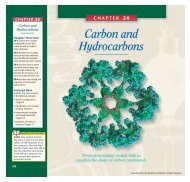Physical Characteristics of Gases
Physical Characteristics of Gases
Physical Characteristics of Gases
You also want an ePaper? Increase the reach of your titles
YUMPU automatically turns print PDFs into web optimized ePapers that Google loves.
RESEARCH NOTES<br />
Carbon Monoxide Catalyst—<br />
Stopping the Silent Killer<br />
C olorless, odorless, and deadly—<br />
carbon monoxide, “the silent<br />
killer,” causes the deaths <strong>of</strong> hundreds<br />
<strong>of</strong> Americans every year.<br />
When fuel does not burn completely<br />
in a combustion process,<br />
carbon monoxide is produced.<br />
Often this occurs in a malfunctioning<br />
heater, furnace, or fireplace.<br />
When the carbon monoxide is<br />
inhaled, it bonds to the hemoglobin<br />
in the blood, leaving the body<br />
oxygen starved. Before people<br />
realize a combustion device is<br />
malfunctioning, it’s <strong>of</strong>ten too late.<br />
O 2 Hb + CO ⎯→ COHb + O 2<br />
Carbon monoxide, CO, has almost 200 times<br />
the affinity to bind with the hemoglobin,<br />
Hb, in the blood as oxygen. This means if<br />
the body has a choice, it will bind to carbon<br />
monoxide over oxygen. If enough carbon<br />
monoxide is present in the blood, it can be<br />
fatal.<br />
Carbon monoxide poisoning<br />
can be prevented by installing<br />
filters that absorb the gas. After<br />
a time, however, filters become<br />
saturated, and then carbon<br />
monoxide can pass freely into the<br />
air. The best way to prevent carbon<br />
monoxide poisoning is not<br />
just to filter out the gas, but to<br />
eliminate it completely.<br />
Copyright © by Holt, Rinehart and Winston. All rights reserved.<br />
The solution came to research<br />
chemists at NASA who were<br />
working on a problem with a<br />
space-based laser. In order to<br />
operate properly, NASA’s spacebased<br />
carbon dioxide laser needed<br />
to be fed a continuous supply <strong>of</strong><br />
CO 2 . This was necessary because<br />
as a byproduct <strong>of</strong> its operation, the<br />
laser degraded some <strong>of</strong> the CO 2<br />
into carbon monoxide and oxygen.<br />
To address this problem, NASA<br />
scientists developed a catalyst<br />
made <strong>of</strong> tin oxide and platinum<br />
that oxidized the waste carbon<br />
monoxide back into carbon<br />
dioxide. The NASA scientists then<br />
realized that this catalyst had the<br />
potential to be used in many<br />
applications here on Earth, including<br />
removing carbon monoxide<br />
from houses and other buildings.<br />
Typically, a malfunctioning<br />
heater circulates the carbon<br />
monoxide it produces through its<br />
air intake system back into a<br />
dwelling space. By installing the<br />
catalyst in the air intake, any carbon<br />
monoxide would be oxidized<br />
to non-toxic carbon dioxide before<br />
it reentered the room.<br />
“The form <strong>of</strong> our catalyst is a<br />
very thin coating on some sort <strong>of</strong> a<br />
support, or substrate as we call it,”<br />
says NASA chemist David<br />
Schryer. “And that support, or<br />
substrate, can be any one <strong>of</strong> a<br />
number <strong>of</strong> things. The great thing<br />
about a catalyst is that the only<br />
thing that matters about it is its<br />
surface. So a catalyst can be<br />
incredibly thin and still be very<br />
effective.”<br />
The idea <strong>of</strong> using catalysts to<br />
oxidize gases is not a new one.<br />
Catalytic converters in cars oxidize<br />
carbon monoxide and<br />
unburned hydrocarbons to minimize<br />
pollution. Many substances<br />
are oxidized into new materials<br />
for manufacturing purposes. But<br />
both <strong>of</strong> these types <strong>of</strong> catalytic<br />
reactions occur at very high temperatures.<br />
NASA’s catalyst is special,<br />
because it’s able to eliminate<br />
carbon monoxide at room temperature.<br />
According to David Schryer,<br />
low-temperature catalysts constitute<br />
a whole new class <strong>of</strong> catalysts<br />
with abundant applications for the<br />
future.<br />
How did NASA’s research on the<br />
space-based carbon dioxide laser<br />
result in a benefit for consumers?<br />
NSTA<br />
TOPIC: Carbon monoxide<br />
GO TO: www.scilinks.org<br />
sci LINKS CODE: HC2103<br />
PHYSICAL CHARACTERISTICS OF GASES 307<br />
SECTION 10-1<br />
RESEARCH NOTES<br />
Common<br />
Misconception<br />
Students may think that all effects<br />
<strong>of</strong> carbon monoxide are undesirable.<br />
The gas has some important useful<br />
applications. It is used to reduce<br />
metallic ores to pure metals. It is also<br />
an important component <strong>of</strong> several<br />
industrial fuels.<br />
Application<br />
Pollution-control devices like the one<br />
described here have been partially<br />
responsible for a 28 percent reduction<br />
in carbon monoxide levels in urban<br />
areas <strong>of</strong> the United States between<br />
1984 and 1992. Still, many urban<br />
areas have carbon monoxide levels<br />
that exceed the minimum standards<br />
established by the United States<br />
Environmental Protection Agency.<br />
Answer<br />
Developing a tin oxide and platinum<br />
catalyst to oxidize the carbon<br />
monoxide byproduct <strong>of</strong> the laser<br />
provided the technology to reduce<br />
the effects <strong>of</strong> harmful carbon<br />
monoxide gas in homes.<br />
HANDBOOK CONNECTION<br />
More-detailed information on CO<br />
poisoning can be found in Group 14<br />
<strong>of</strong> the Elements Handbook.<br />
307

















